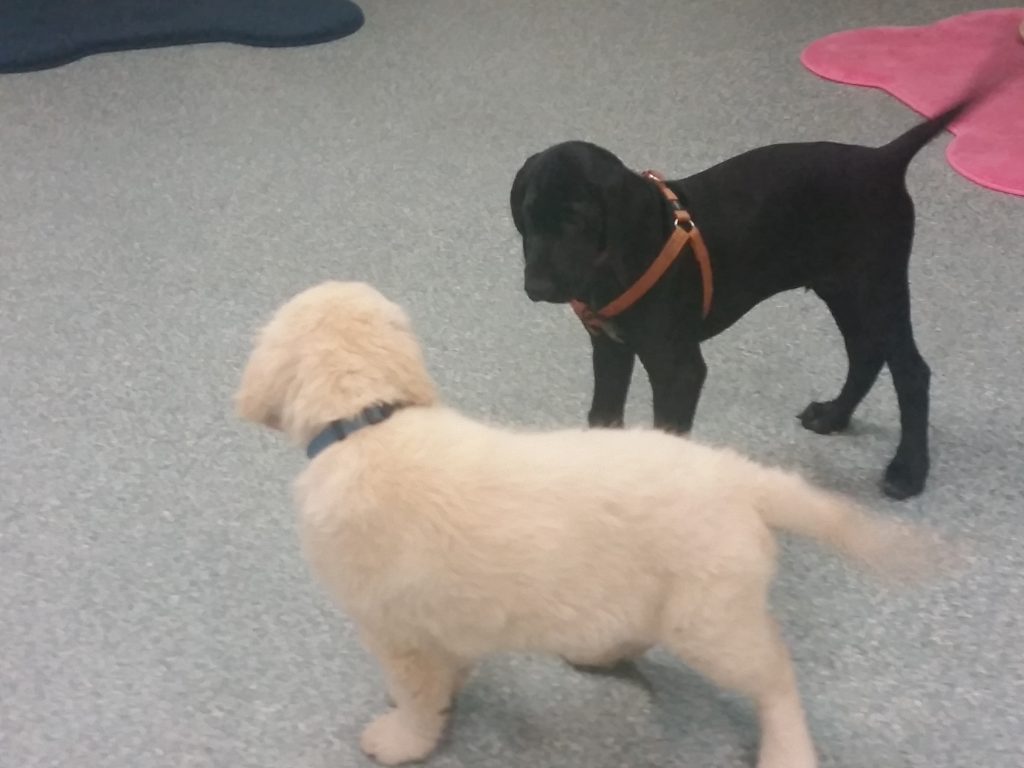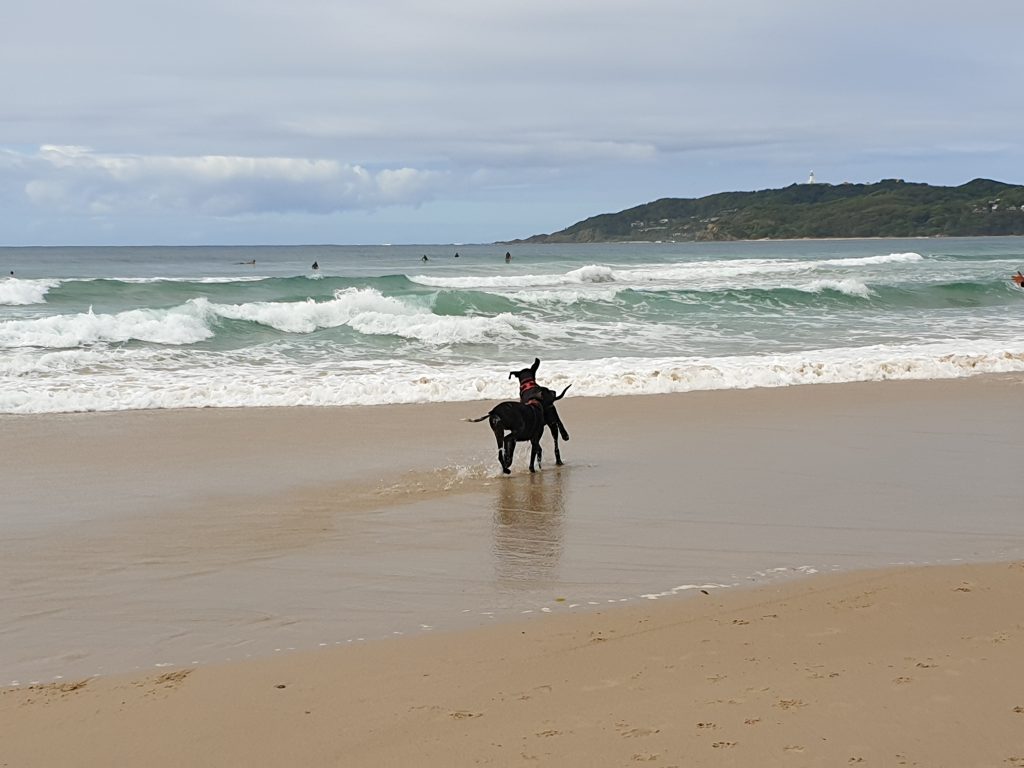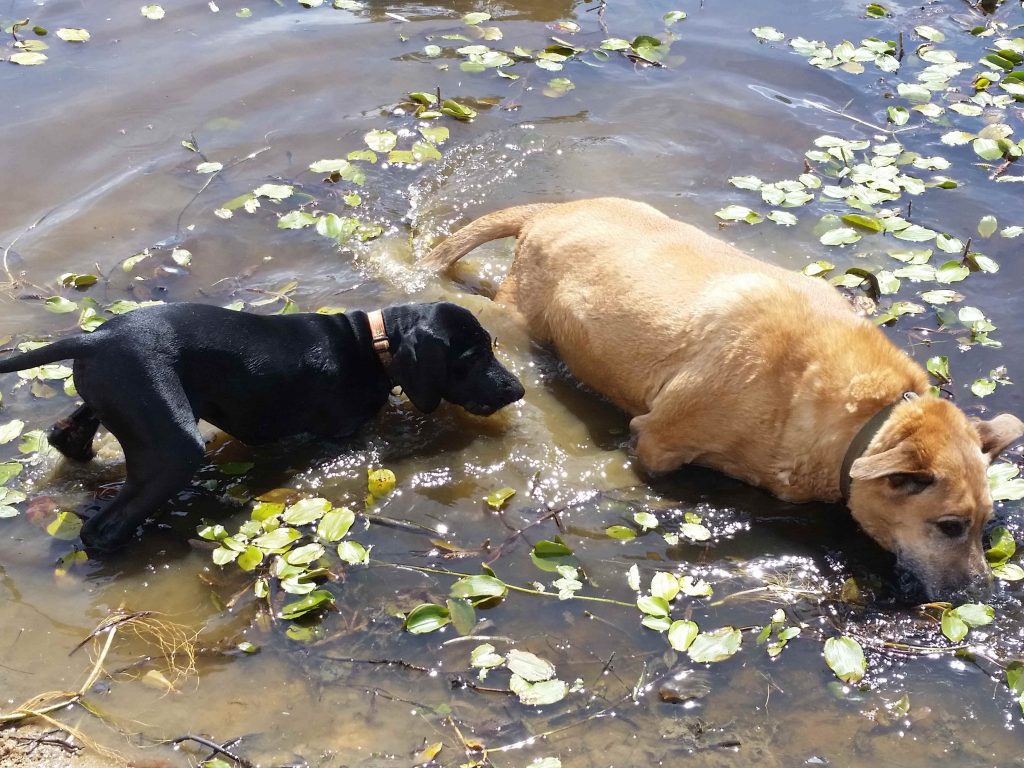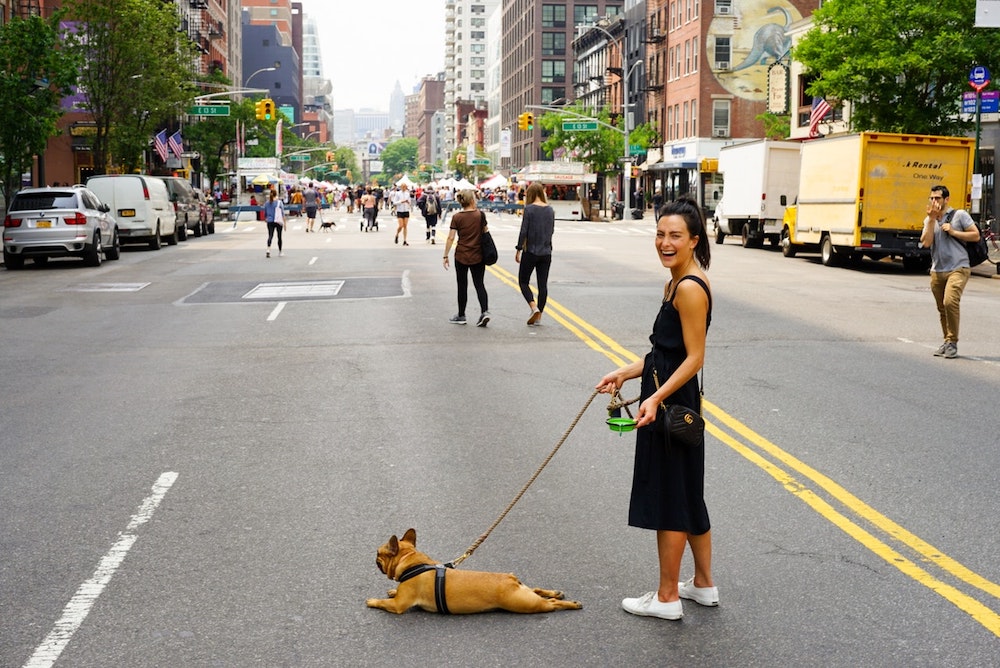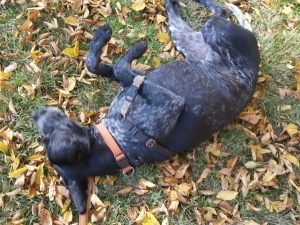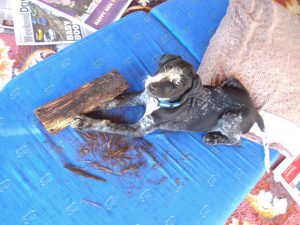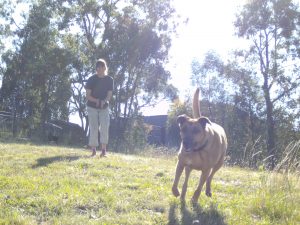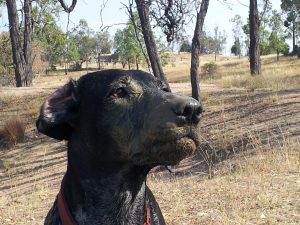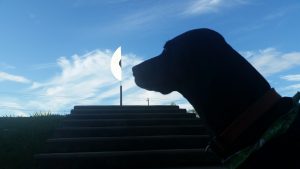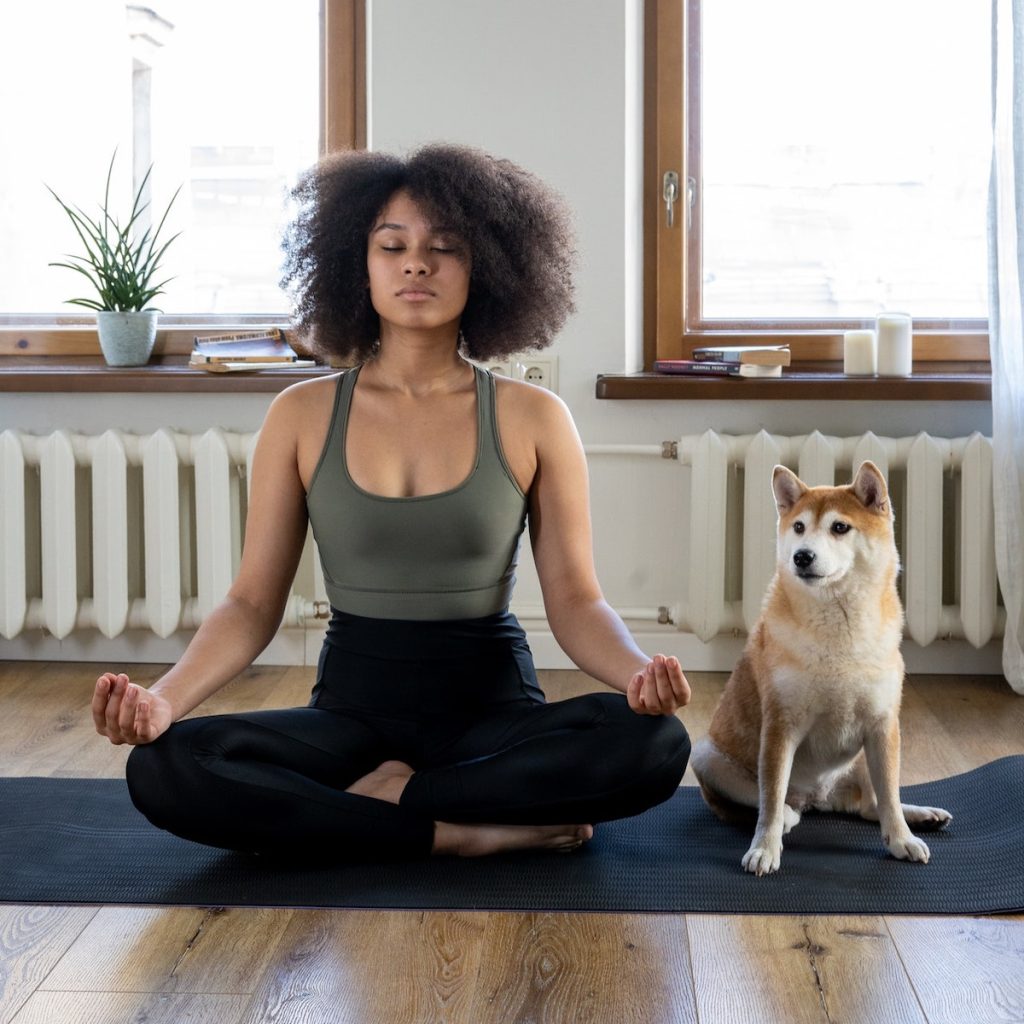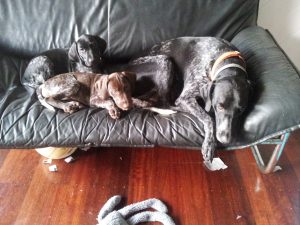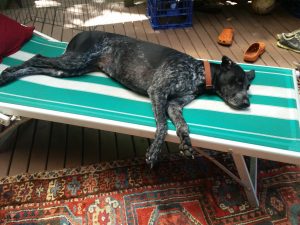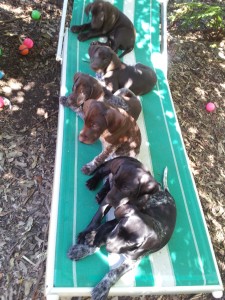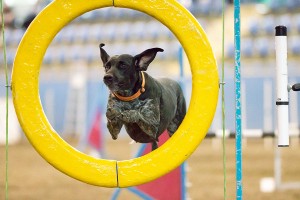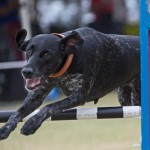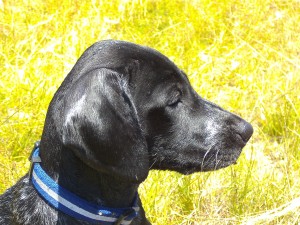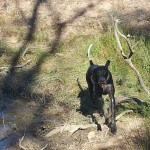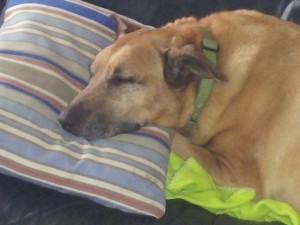Want to know how to help your teenage dog and keep your sanity? Goodog owner Barbara Hodel answered this question for Australian Dog Lover.
By Barbara Hodel July 2020 – reposted from Australian Dog Lover
(all rights reserved)
Is your dog jumping on you and your visitors, pulling like a freight train and does not come when called? Does she have selective hearing and forgotten all her training? Or does he dig up the yard, barks at every noise and anything that moves, or now struggles with being home along? Then you probably have a teenage dog! I call the barking and digging dogs the unemployed teenage dogs, who have now become self-employed in the security or excavation industry. Read more about teenage dogs below and book into a Goodog Teenage Course if you need some help with your dog.
When do dogs become teenagers?
Dogs enter the teenage phase around seven to eleven months and reach adulthood around 18 to 24 months. Smaller dogs become teenagers earlier than larger dogs and mature earlier, too. Some breeds mature late, for example the large gun dogs, while working dogs like Kelpies or Border Collies mature earlier, but there are always individual differences.
Is there really such a thing as a teenage dog? Science says so.
Until recently we did not talk about teenage dogs and there was limited science around that topic. However, it seems that what trainers have been saying for years is now being confirmed by solid science!

📷 Grazia Pecorara
A recent research article: “Teenage dogs? Evidence for adolescent-phase conflict behaviour and an association between attachment to humans and pubertal timing in the domestic dog“ [1], indicates that owners are not just imagining that their dog has become an erratic teenager but that dog teenagehood is real and so are its challenges.
While we need science to confirm our own anecdotal evidence, for parents of human teenagers the parallels are clear! It looks too similar: the emotional response and over the top reactions to some stimuli, screaming for no obvious reason, trying to be independent and at the same time a strong need for being loved.
While there are countless articles and books on puppies, good information on teenage dogs is difficult to find. But all dogs (and humans) need to go through teenage phase to reach the stability of adulthood and often it is not pretty!
It is a difficult time because teenage dogs need a lot of mental and physical stimulation. But at the same time, they become easily scared because they are going through secondary fear phases. They also become more selective who they consider friends and who they will play with.
Taking a young dog out for daily exercise when they startle at the sight of a man wearing a fluoro vest, do not come when called, and start fighting at the dog park is challenging.
More obedience training or a ‘tougher’ approach will not solve the problem. Obedience training is great to address the problems like pulling on the leash and ignoring the calls to come back, but to be successful we need to have some foundations in place BEFORE we start training the mentioned obedience behaviours.
The first thing we need to remind ourselves is that they are not being ‘difficult’ on purpose or stubborn, defiant or stupid. The different parts of their brain are developing at a different pace and are not communicating properly with each other.
Because of this, they are having difficulties making good and calm decisions.
Prerequisites for successful training are a good relationship, an open line of communication and trust!
Another prerequisite for success is that we have catered to their physical, mental and social needs. I see too many humans and their teenage dogs who are frustrate because they try to train without these foundations and it is all downhill from there.
The relationship matters!

We all know that good relationships are no coincidence and we also know that good relationships are a lot of work.
Traditionally, our relationship with dogs was defined by control, dominance and coercion. We used commands and choice was an unknown concept. For humans, an unhealthy relationship is defined as one that is based on power and control and not equality and respect. I think it is time to treat and respect our dogs as friends!
A good relationship means we need time (and a lot of it) to spend together. Humans are often surprised when I say that we need two to three hours of quality time with our teenage dogs daily. That is not counting the time they spend with us on the couch in front of the TV. But the time on the couch is also important because being together allows for bonding. This is one of the reasons dogs need to have access to our living areas and not spend their time outside in the backyard.
Quality time should consist of leisurely outings, play, going to the coffee shop, a run at the park, games, teaching tricks or a bush walk. Things both humans and dogs enjoy.
Giving them a bit more choice like different sleeping places, occasionally letting them decide which way we walk (as long as it is safe) or let them choose between chicken or beef for dinner is beneficial for their mental wellbeing and good for the relationship.
Communication is the key – Do not wait until they scream!
Dogs do not speak our language but they are experts in body language. It is therefore important that we understand what they are saying. Most humans will realise when our dog gets really upset and scared. Dog aggression is often caused by fear. But if we listen (or more accurately watch carefully) they do not need to scream and shout or lash out! We need to watch for early stress signs of stress to avoid full blown outbursts.
The early stress signs have a lot of different names but I like calling them displacement behaviours because that describes what we see; normal behaviours displayed out of context. The most common ones are:
✔️ Lip licking
✔️ Yawning
✔️ Head turns
✔️ Shake offs
✔️ Intent sniffing
Dogs will lick their lips when we hold a treat in front of their nose, yawn when tired, shake off when wet, turn their head if someone enters the room and sniff if there is an interesting smell. But if they do any of these when on a walk and a dog or a child on a scooter approaches, then it pays to pay attention and increase distance.
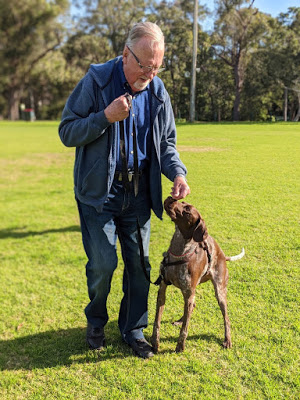
We need to help them to cope in a situation they find challenging. Asking them to sit will either not work because they are too stressed to do it or they simply cannot hear us because they are focused on the other dog or the child.
Giving them more space will set them up for success. It will also increase trust in us because we have helped them to cope with this situation.
Teaching them the basics such as ‘look at me’, hand touch and a few simple tricks with positive reinforcement methods will help with our relationship and mutual understanding.
Keeping them busy with daily enrichment will calm things down.
Catering to their needs means that, in addition to the ‘traditional’ walk and a good run, we should take them out for ‘sniffaris’ where they can sniff and explore at their leisure.
We should also provide daily enrichment [2]. This includes:
✔️ social enrichment (contact with others)
✔️ occupation (giving them a job such as a dog sport)
✔️ sensory (sights, music, scents e.g. canine sensory garden)
✔️ nutritional (such as foraging)
✔️ physical enrichment (toys, physical features in the yard).
This will help addressing the barking and digging!
We have given our unemployed teenage dog a proper job and they are not bored out of their minds. This will help them to be calm when home alone, but also improve focus when training and they will be more relaxed when out and about.
Once we understand and trust each other and we have catered to their needs, training will be much easier!
My favourite ‘obedience’ behaviour for teenage dogs: Doggy-Zen:
Doggy-Zen it is more than just an obedience behaviour. This is not a cued behaviour, but rather a relaxation exercise. Like us, our teenage dogs need to learn to de-stress and calm their mind. Anyone who has done yoga or meditation knows that calming the mind is not easy and dogs are no different. Once they are stressed or just excited it is difficult to calm down.
I have found Doggy-Zen to be a good way of slowing things down for our dogs. For the Doggy-Zen exercise, we show our calm dog the treat (in our hand) and then extend our arm out fully to the right of our head (at eye level). We then wait until our dog takes their eyes off the treat and gives us eye contact.
We must not say anything. Once we get eye contact, we mark and reinforce (meaning either click or say yes and deliver a treat). In the beginning we mark and reinforce for every glance! But as our dogs improve, we wait longer and will reinforce only for extended eye contact. We aim for five to ten seconds.
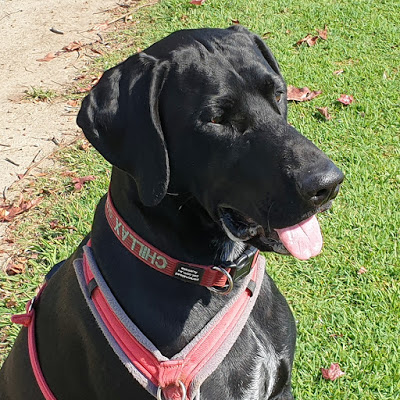
📷 Barbara Hodel
Because this exercise is not cued our dog needs to figure out what gets them the treat. An excited dog has a hard time taking their eyes off the treat because the shortest way to the treat is looking at the hand with the treat.
However, in this case, that is not working. To get the treat they need to take their eyes off the treat and look at us.
When they are excited their brain is not processing information properly and they have poor impulse control which makes it difficult for them to figure it out. A typical teenage problem! But, once they calm down, they are able to take their eyes off the treat and look at us. We can literally watch them relax and often, they will take a deep breath, too.
We should practice this ‘meditation’ initially when they are calm, as this will help create a pathway in the brain that promotes relaxation. Once our dog understands this exercise, we can start practising in more ‘exciting’ environments. Because we have practised this relaxation exercise and have create new pathways in the brain, they can now do it even when they are excited.
The many benefits of Trick Training
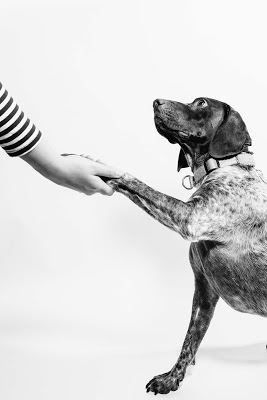
Every dog should learn a few tricks: it is fun, improves our relationship with them and is a great way to keep our teenage dog’s brain busy. Another main reason for trick-training is that it improves our training technique.
We are often tense when we try to teach our dogs basic things like Sit or Lie-down. But, as soon as we teach tricks – for example Shake-paw, Spin, Weave-through-my-legs or Sit-pretty – we all lighten up, have fun andengage on a different level with our dogs.
Because us humans have changed our mind set – we are more engaging and start to have fun – the dogs pick up on this and become more engaged and are keener to work and play with their humans.
It also seems that when we realise that our own attitude and behaviour influences our dogs, we are more likely to have a positive attitude with the ‘boring’ but necessary obedience behaviours.
Like in any other relationship, as soon as we relax and have fun, everything works better! One of the easier tricks is Weave-through-my-legs. Our dog stands facing us. We reach through our legs and lure them between and around our left leg and then the right leg in a figure-eight.
Some dogs might find this a bit a scary and it helps if we teach them to go through our legs first by throwing a treat through our legs, behind us.
The only thing they need to do in the beginning is to run through our legs to get the treat. Most dogs will feel comfortable with this quickly.
Having a treat in each hand will help with the flow and our co-ordination. Once they have learnt the trick, it is often enough for us to stand with our legs apart and give the verbal cue weave and they will happily do it.
For more tricks and information on teenage dogs and how to understand and teach them check out the new “How to love and survive your teenage dog” book (publishing August 2020) – Print $29 plus postage and E-book $24, available for pre-order at www.goodog.com.au
If you want to know more about how to help your teenage dog and keep your sanity, grab a copy of Goodog owner Barbara Hodel’s book: How to love and survive your teenage dog
About the Writer
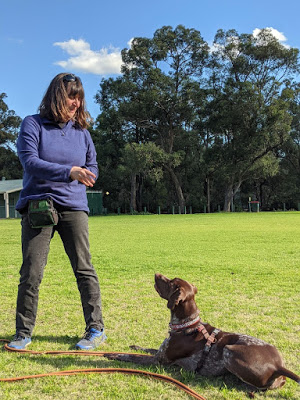
In 2015 Barbara Hodel, the author of How to love and survive your teenage dog (published in 2020), completed her Diploma in Canine Behaviour Science and Technology at the Companion Animal Sciences Institute in Canada (http://casinstitute.com).
Barbara has been running her dog training business Goodog (www.goodog.com.au) on the Northern Beaches Sydney for over 14 years specialising in teenage dogs, offering classes and in home consultations for young dogs as well as workshops for typical teenage challenges such as recall and loose leash walking.
She has been involved in dog training for the last 20 years and has completed her Certificate IV in Companion Animal Services with the Delta Society in 2007 and is a professional member of the Delta Institute.
Barbara competes in the dog sport of Agility and Rally O with Shellbe (a German short-haired pointer) on Master level. Chillax, one of Shellbe’s puppies, competes in Rally O and got his Rally Novice title in October 2019. He is just starting out in Agility.
Barbara is the President of the Pet Professional Guild Australia. The Guild promotes force free and humane training for all pets
She is also a registered breeder with Dogs NSW.
Barbara holds a Master’s Degree in Modern European History and Economics from the University of Berne (Switzerland) and a MBA (Master of Business Administration) from Southern Cross University Australia. In addition, Barbara has in-depth experience in adult education and training, having taught high school and university students in Berne, college students in Sydney, as well as middle and top management employees of a large public corporation in Switzerland.
Teenage Courses:
- Balgowlah: Monday’s 11:15am
- Seaforth: Monday’s 6pm
- Terrey Hills: Wednesday’s 7:10pm
- Collaroy: Thursday’s 5:45pm
- Full listing: Our Next Classes
Teenage class info: Goodog Teenage Class
Bookings: Our Next Classes
Enquiries: renee@goodog.com.au
References
[1] Asher, L., England, G., Sommerville, R. & Harvey, N. (2020). Teenage dogs? Evidence for adolescent-phase conflict behaviour and an association between attachment to humans and pubertal timing in the domestic dog, The Royal Society, Vol. 16, Issue. 5, pp. 1–5. https://doi.org/10.1098/rsbl.2020.0097
[2] Garvey, M., Stella, J. & Croney, C. (2016). Implementing environmental enrichment for dogs, Center For Animal Welfare Science, Purdue Extension. https://extension.purdue.edu/extmedia/VA/VA-13-W.pdf

